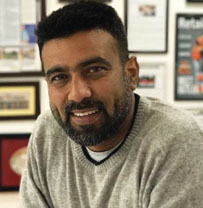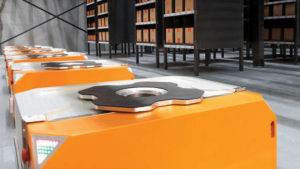Tiger Global and Blume Ventures funded GreyOrange, a company that manufactures and deploys advanced robotics systems for automation at warehouses, distribution and fulfilment centres, is all set to serve new verticals like pharma and retail and expand into newer geographies across Europe.

GreyOrange’s journey began way back in 2011 when its founders, Samay Kohli and Akash Gupta, decided do something about the passion they had for robotics, specifically in the industrial context. At a first level, the team realized the automation in warehouses was abysmally low.
“The level of automation in India was much lower when compared to markets like US and China, but this presented a wonderful opportunity,” says Vikrant Yadav, Country Manager, India, GreyOrange.
“Additionally, the pressure on warehouses to become more efficient was clear. It was a critical part of the overall supply chain,” he explains. Therefore, the company chose to build hardware robotic solutions to solve complex supply chain problems and transform the way logistics and supply chain processes across the world were being optimized.
Today, GreyOrange is recognised as one of the world’s Top 50 Robotics Companies by Robotics Business Review. The company has been at the forefront of warehouse automation innovation, by offering solutions for various industries. Headquartered in Singapore with offices in India, Hong Kong, Japan, Germany and UAE and a research and development centre in Gurgaon, the company has raised US $35 million (in series A and B funding) from global venture capital firms – Tiger Global Management and Blume Ventures, and some angel investors. It has over 650 employees and aims to further double the head count to meet its expansion goals. “38.7 per cent of the workforce is dedicated to R&D as a sacrosanct requirement within the company,” says Yadav. There are a total of 55 installations in India and the company has grown 300 per cent on a year-on-year basis.
Till now, we were restricted to cater to serve First/Last mile Order Fulfilment requirement for our customers. However, we have recently figured out how our solutions are fit for back of factory warehouse needs as well
![]()
The implementation drive
The company’s marquee solutions Butler (goods-to-person inventory storage and picking and combining system) and Sorter (modular system for automating sorting processes in warehouses and fulfilment centres) have been deployed at client sites across Japan, Singapore, Hong Kong, and India, helping them increase efficiency multi-fold and improve last mile delivery. Some of the clients include e-commerce players such as Flipkart, Myntra, Jabong and Pepperfry; and logistics players such as Aramex, Gojavas, DTDC, Delhivery, Kerry Logistics (Hong Kong), Ninja Van (Singapore), Nitori Holdings Group (Japan). The key value proposition for a client includes – ability to manage peak times better, increased operator efficiency, predictability and real-time data tracking to enable better business decisions.
GreyOrange Sorter is an advanced robotic sortation system that automates outbound profiling and sortation process in fulfilment and distribution centres. Butler is an automated storage and goods-to-person order picking robotic system to streamline and accelerate the order fulfilment process. “Reducing order fulfilment and inventory replenishment time in warehouses is imperative for businesses today to gain a competitive advantage,” says Yadav. With a throughput of up to 600 picks per hour per pick station, the GreyOrange Butlers help accelerate order fulfilment and inventory replenishment time, while enabling warehouse managers to reduce stock losses and pilferage by tracking inventory in real-time.
These solutions are not force fitted into a warehouse but are customized to meet the specific needs and can work in almost any kind of warehouse environment.
The growth path
So far the company has restricted itself to serve first/last mile order fulfilment requirement for its customers. “However, we have recently figured out how our solutions will be a good fit for back of factory warehouse needs as well,” says Yadav. For instance, one of its key customers sought them out to customise the solution for not just picking and putting for finished goods but for raw and packing materials as well. “And we have provided a complete industry 4.0 solution for first mile and back of factory requirements,” adds Yadav.
What has worked for the company so far is its ability to pivot its business plans to include industries and solutions as it has progressed in its journey. “And in the years to come, we see GreyOrange entering new industries/verticals like pharma and apparel retail. Further, we would be expanding into newer geographies across Europe, having recently set up an office in Germany,” says Yadav. From an ecosystem perspective, the company will be focusing on building stronger partnerships with new players in the automation space.

Opportunity:
The use of robotics for industrial automation – in warehouse, fulfilment centres and back of factors floors presented a tremendous opportunity.
Solution:
It builds hardware robotic solutions to solve complex supply chain problems and transform the way logistics and supply chain processes across the world are being optimized. Its solution ‘Butler’ is an automated storage and goods-to-person order picking robotic system to streamline and accelerate the order fulfilment process while GreyOrange’s other product ‘Sorter’ is an advanced robotic sortation system that automates outbound profiling and sortation process in fulfilment and distribution centres.
Snapshot: GreyOrange
Founders: Samay Kohli and Akash Gupta
Year: 2011
Funding: Raised US $35 million (in series A and B funding) by global venture capital firms – Tiger Global Management and Blume Ventures
Profile: GreyOrange is a company that manufactures and deploys advanced robotics systems for automation at warehouses, distribution and fulfilment centres. The company found opportunity in the industrial automation space in India, given that the current level of automation is very low as compared to other markets like USA or China. This apart, the pressure on warehouses for delivering faster and at lower costs is increasing the need for automation. Therefore, the company chose to build hardware robotic solutions to solve complex supply chain problems and transform the way logistics and supply chain processes across the world are being optimized.

